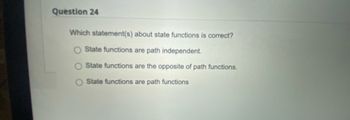
Chemistry
10th Edition
ISBN: 9781305957404
Author: Steven S. Zumdahl, Susan A. Zumdahl, Donald J. DeCoste
Publisher: Cengage Learning
expand_more
expand_more
format_list_bulleted
Concept explainers
Question

Transcribed Image Text:Question 24
Which statement(s) about state functions is correct?
State functions are path independent.
State functions are the opposite of path functions.
State functions are path functions
Expert Solution
This question has been solved!
Explore an expertly crafted, step-by-step solution for a thorough understanding of key concepts.
Step by stepSolved in 2 steps

Knowledge Booster
Learn more about
Need a deep-dive on the concept behind this application? Look no further. Learn more about this topic, chemistry and related others by exploring similar questions and additional content below.Similar questions
- Physical Chemistry, question is in the image, can you work it out and write down exactly which equations that you're using?arrow_forwardWhich of the following is not considered an extensive property? O Weight O Temperature O Entropy Volumearrow_forwardPlease don't provide handwritten solution ....arrow_forward
- Calulate the eneray change of a systemarrow_forwardA certain reaction has Ho = -66.40 kJ and So = 0.00 J/K.(a) Is this reaction exothermic, endothermic or isothermic (neither)?This reaction is.(b) Does this reaction lead to a decrease, an increase, or no change in the degree of disorder in the system?This reaction leads to in the disorder of the system.(c) Calculate Go for this reaction at 298 K. If this value is less than 1 kJ/mol then enter 0 in the answer box.Go = kJ.(d) Is this reaction spontaneous, nonspontaneous, or near equilibrium under standard conditions at 298 K?This reaction is under these conditions.arrow_forwardWhich of the following is not a state function? a. Т O b. H O c. S O d. None; they are all state functions. O e. Uarrow_forward
- Arrange the states of matter in order of decreasing entropy.arrow_forwardAt - 16.4 °C the pressure equilibrium constant K, = 7.4 for a certain reaction. Here are some facts about the reaction: • The constant pressure molar heat capacity C, = 1.04 J'mol. K. %3D • The reaction is endothermic. • If the reaction is run at constant pressure, the volume increases by 13.%. Yes. Using these facts, can you calculate K, at - 33. °C? O No. If you said yes, then enter your answer at right. Round it to 2 significant digits. Yes, and K, will be bigger. If you said no, can you at least decide whether K, at - 33. °C will be bigger or smaller than K, at - 16.4 °C? Yes, and K, will be smaller. No.arrow_forward4. Which of the following is always true for an exothermic process? A. qsys > 0, ASsurr 0 C. qsys 0, ASsurr > 0arrow_forward
- The change of energy of a thermodynamic system is equal to: the amount of work done to or by the system and the amount of heat gained or lost. O the amount of heat gained or lost. O impossible to calculate the change in energy O the amount of work done to or by the system.arrow_forward4. For a chemical reaction that has a AGº value of +275 kJ/mol, what value must Q have for this system to be at equilibrium? Show all work. 30 281 SASarrow_forwardConsider the thermodynamic quantities E, 9, and w. Which of these quantities are state functions?arrow_forward
arrow_back_ios
SEE MORE QUESTIONS
arrow_forward_ios
Recommended textbooks for you
 ChemistryChemistryISBN:9781305957404Author:Steven S. Zumdahl, Susan A. Zumdahl, Donald J. DeCostePublisher:Cengage Learning
ChemistryChemistryISBN:9781305957404Author:Steven S. Zumdahl, Susan A. Zumdahl, Donald J. DeCostePublisher:Cengage Learning ChemistryChemistryISBN:9781259911156Author:Raymond Chang Dr., Jason Overby ProfessorPublisher:McGraw-Hill Education
ChemistryChemistryISBN:9781259911156Author:Raymond Chang Dr., Jason Overby ProfessorPublisher:McGraw-Hill Education Principles of Instrumental AnalysisChemistryISBN:9781305577213Author:Douglas A. Skoog, F. James Holler, Stanley R. CrouchPublisher:Cengage Learning
Principles of Instrumental AnalysisChemistryISBN:9781305577213Author:Douglas A. Skoog, F. James Holler, Stanley R. CrouchPublisher:Cengage Learning Organic ChemistryChemistryISBN:9780078021558Author:Janice Gorzynski Smith Dr.Publisher:McGraw-Hill Education
Organic ChemistryChemistryISBN:9780078021558Author:Janice Gorzynski Smith Dr.Publisher:McGraw-Hill Education Chemistry: Principles and ReactionsChemistryISBN:9781305079373Author:William L. Masterton, Cecile N. HurleyPublisher:Cengage Learning
Chemistry: Principles and ReactionsChemistryISBN:9781305079373Author:William L. Masterton, Cecile N. HurleyPublisher:Cengage Learning Elementary Principles of Chemical Processes, Bind...ChemistryISBN:9781118431221Author:Richard M. Felder, Ronald W. Rousseau, Lisa G. BullardPublisher:WILEY
Elementary Principles of Chemical Processes, Bind...ChemistryISBN:9781118431221Author:Richard M. Felder, Ronald W. Rousseau, Lisa G. BullardPublisher:WILEY

Chemistry
Chemistry
ISBN:9781305957404
Author:Steven S. Zumdahl, Susan A. Zumdahl, Donald J. DeCoste
Publisher:Cengage Learning

Chemistry
Chemistry
ISBN:9781259911156
Author:Raymond Chang Dr., Jason Overby Professor
Publisher:McGraw-Hill Education

Principles of Instrumental Analysis
Chemistry
ISBN:9781305577213
Author:Douglas A. Skoog, F. James Holler, Stanley R. Crouch
Publisher:Cengage Learning

Organic Chemistry
Chemistry
ISBN:9780078021558
Author:Janice Gorzynski Smith Dr.
Publisher:McGraw-Hill Education

Chemistry: Principles and Reactions
Chemistry
ISBN:9781305079373
Author:William L. Masterton, Cecile N. Hurley
Publisher:Cengage Learning

Elementary Principles of Chemical Processes, Bind...
Chemistry
ISBN:9781118431221
Author:Richard M. Felder, Ronald W. Rousseau, Lisa G. Bullard
Publisher:WILEY